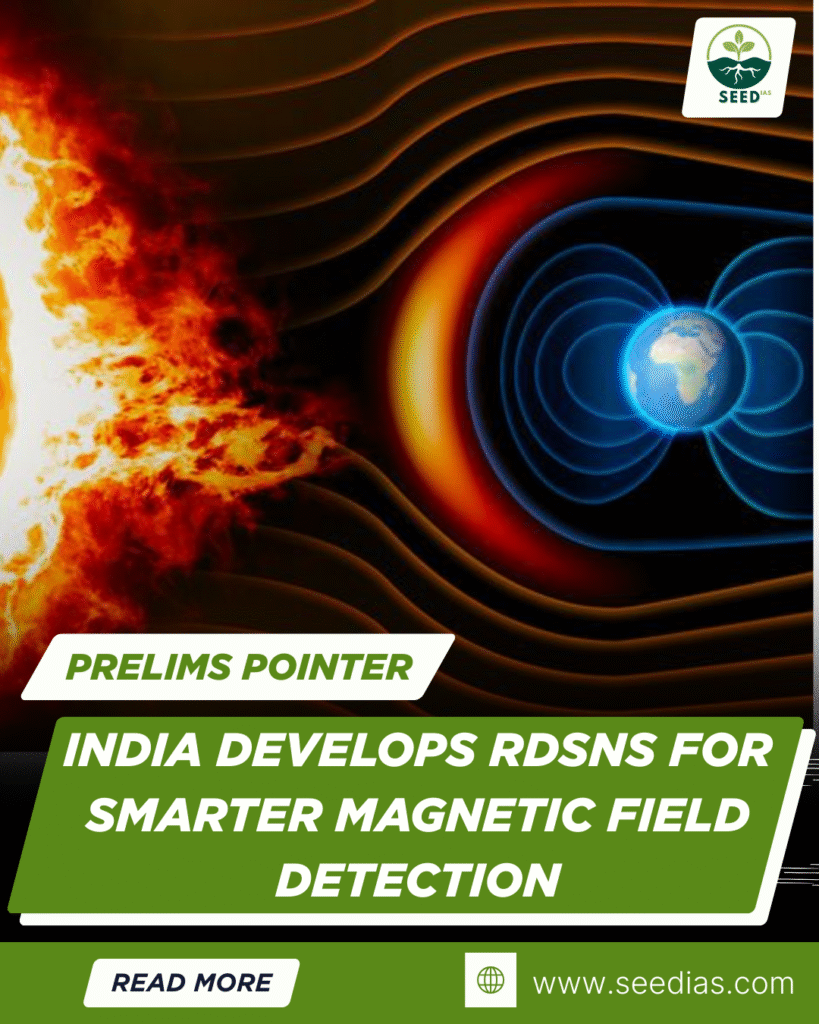Why in NEWS
Scientists at the Raman Research Institute (RRI), Bengaluru, have developed Raman-Driven Spin Noise Spectroscopy (RDSNS) — an advanced laser-based technique to improve magnetic field sensing through a quantum magnetometer, with high sensitivity and outdoor functionality. This innovation reduces the need for shielded lab environments and expands real-world applications in medicine, geology, defense, and space science.
Key Terms and Concepts
| Term | Explanation |
|---|---|
| RDSNS (Raman-Driven Spin Noise Spectroscopy) | A technique using laser light and Rubidium atoms to measure magnetic fields based on changes in natural atomic spin noise. |
| Spin Noise | Random spin fluctuations in atoms that change under magnetic fields — used for non-invasive magnetic sensing. |
| Quantum Magnetometer | Device using quantum properties (like atomic spin) for detecting magnetic fields with high accuracy. |
| Rubidium Atoms | Alkali metal atoms sensitive to light and magnetic fields, ideal for precision quantum measurements. |
| Magnetometer | Instrument for measuring magnetic field strength/direction; used in exploration, imaging, and space studies. |
| Magnetic Shielding | Layers of material used to block unwanted magnetic interference in sensitive instruments. |
| OPAM (Optically Pumped Atomic Magnetometer) | Uses lasers to detect magnetic fields but requires low-noise shielded labs. |
| SERF Magnetometer | Spin-Exchange Relaxation-Free magnetometer; high precision but limited to specific lab environments. |
Key News Details
- About RDSNS:
- Developed by Raman Research Institute, Bengaluru.
- Uses laser light and Rubidium atoms to sense spin noise.
- Measures magnetic fields by detecting how noise patterns change with field intensity.
- It’s a non-invasive, all-optical method, requiring no contact or interference.
- Why It’s Special:
- Works without magnetic shielding — unlike OPAM or SERF magnetometers.
- Is portable, field-deployable, and resistant to external noise (mechanical/electrical).
- Measures magnetic fields over a wide dynamic range.
- Applications:
- Medical Imaging: An alternative to MRI for brain/organ scans.
- Geological Surveys: Mapping mineral-rich zones, oil exploration.
- Oceanography: Finding wrecks, anchors, basaltic features.
- Space Missions: Studying planetary magnetic fields.
- Quantum Research: Atomic behavior, spin-based systems.
- Modern Magnetometers vs RDSNS:
- OPAM and SERF are lab-confined, need shielding, and have limitations.
- RDSNS breaks this barrier by enabling open-environment operations.
In a Nutshell
Mnemonic: “Rubidium Detects Silent Spin to Sense Strong Signals”
(Rubidium = Atom used, Detects Silent Spin = Spin noise changes, Strong Signals = Magnetic field strength)
Prelims Questions
- Which of the following best describes the function of the RDSNS technique?
a) Measures atmospheric pressure through laser scattering
b) Measures magnetic fields using spin noise of atoms
c) Detects radiation from UV and X-ray emissions
d) Uses sound waves to scan underwater structures - Consider the following statements:
- RDSNS requires expensive magnetic shielding for accurate functioning.
- Rubidium atoms are used in RDSNS for their high magnetic sensitivity.
- SERF magnetometers are commonly deployed in outdoor settings.
Which of the above is/are correct?
a) 2 only
b) 1 and 3 only
c) 1 and 2 only
d) 2 and 3 only
- Which among the following are possible applications of RDSNS technology?
- MRI alternatives in hospitals
- Mineral surveys
- Ocean floor mapping
Select the correct answer:
a) 1 and 2 only
b) 2 and 3 only
c) 1 and 3 only
d) 1, 2 and 3
Answers to Prelims Questions
| Q. No. | Answer | Explanation |
|---|---|---|
| 1 | b | RDSNS detects changes in spin noise to measure magnetic fields, using laser-light-based sensing. |
| 2 | a | Statement 2 is correct. RDSNS does not require shielding, and SERF magnetometers are lab-bound, not for outdoors. |
| 3 | d | All listed applications – medical imaging, mineral detection, and oceanography – are viable uses of RDSNS. |
















